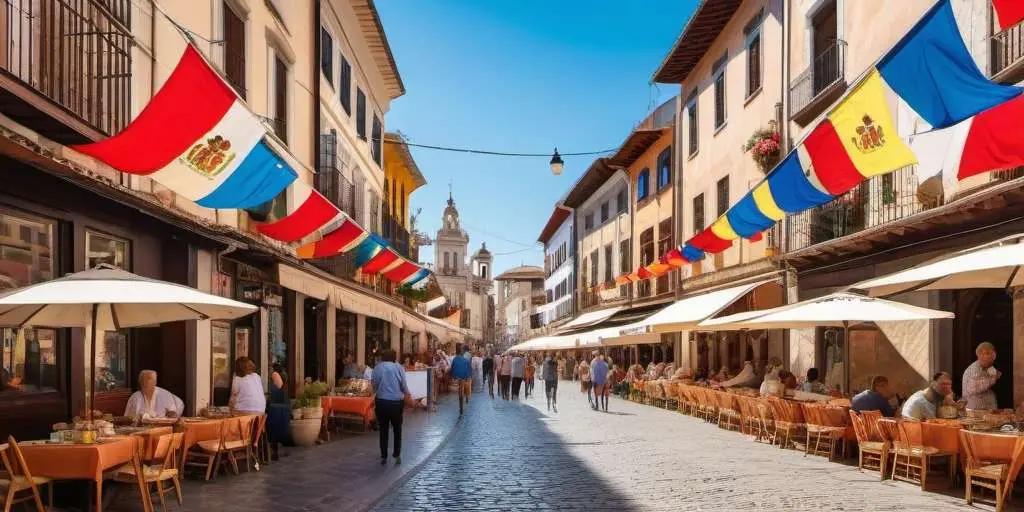Places that speak spanish: Spanish-Speaking Destinations
Spanish-speaking countries are diverse, with a rich language heritage. From Spain to Latin America and beyond, Spanish plays a crucial role in global communication. These places offer unique cultural experiences, reflecting the influence of the Spanish language. Cultural diversity and linguistic richness characterize Spanish-speaking regions, shaping their identity and history.
Overview of Spanish-Speaking Countries
Spanish-speaking countries are diverse and rich in language heritage. The Spanish language has a significant presence globally, with a wide range of countries and territories where it is spoken.
How Many People Speak Spanish?
- Approximately 427 million native Spanish speakers worldwide
- Around 470 million people with native proficiency in Spanish
- An estimated 560 million individuals who speak Spanish as a first or second language
Countries with Spanish as an Official Language
- Spain
- Mexico
- Colombia
- Argentina
- Venezuela
- Peru
- Chile
- Ecuador
- Cuba
- Guatemala
- República Dominicana
- Honduras
- Bolivia
- El Salvador
- Nicaragua
Spanish-Speaking Countries Map
Discover the geographical distribution of Spanish-speaking countries across the world through an interactive map highlighting regions where Spanish is an official or predominant language.
Spanish in Latin America
Latin America is a region rich in Spanish-speaking countries, each with its own unique cultural identity and history. The Spanish language has deep roots in this part of the world, shaping the way people communicate and express themselves.
South America Spanish-Speaking Countries
In South America, countries like Argentina, Peru, and Chile stand out for their vibrant Spanish-speaking communities. Each country has its own dialect and accent, adding to the linguistic diversity of the region.
History of Spanish in Latin America
The history of Spanish in Latin America is closely tied to the colonial period, when Spanish explorers and settlers brought their language to the shores of the New World. Over time, Spanish evolved and adapted to local cultures, influencing the development of unique dialects and expressions.
Spanish Influence in Latin America
The influence of Spanish in Latin America extends beyond language to encompass aspects of culture, art, and traditions. From literature to music, Spanish has left an indelible mark on the region, shaping its identity and sense of belonging.
Spanish in Spain and Equatorial Guinea
Spanish in Spain and Equatorial Guinea showcases the language’s evolution and influence in distinct regions.
Spain: The Origin of the Spanish Language
Spain serves as the birthplace of the Spanish language, with its history and cultural heritage deeply intertwined with the development and spread of the language.
Language Evolution in Spain
Throughout centuries, Spanish evolved from different dialects spoken in various regions of Spain, leading to the establishment of a standardized form known as Castilian.
Cultural Impact of Spanish in Spain
Spanish has played a pivotal role in shaping Spain’s art, literature, and traditions, contributing to its unique identity and cultural richness.
Equatorial Guinea: Spanish as a Spoken Language
In Equatorial Guinea, Spanish serves as a prominent spoken language, reflecting the country’s colonial history and cultural diversity.
Historical Context of Spanish in Equatorial Guinea
Spanish presence in Equatorial Guinea dates back to the colonial period, influencing the country’s linguistic landscape and social dynamics.
Multilingual Society in Equatorial Guinea
Equatorial Guinea’s linguistic diversity, encompassing Spanish, French, and local languages, contributes to the country’s rich cultural tapestry and societal interactions.
Spanish Language Influence in Equatorial Guinea
The influence of the Spanish language in Equatorial Guinea extends beyond communication, impacting education, governance, and cultural expressions within the nation.
Educational System in Equatorial Guinea
Spanish serves as a language of instruction in Equatorial Guinea, influencing the educational curriculum and fostering linguistic proficiency among students.
Cultural Exchange through Spanish
The dissemination of Spanish language and culture in Equatorial Guinea facilitates cultural exchange and international relations, enhancing the country’s global presence.
Spanish in the United States
Spanish holds a significant presence in the United States, shaping various aspects of American society. Let’s explore how the Spanish language influences the country:
Spanish-Speaking Population in the United States
The U.S. boasts a thriving Spanish-speaking population, with over 50 million individuals using Spanish as their primary or secondary language.
Spanish Influence in U.S. Culture
The influence of Spanish culture permeates various aspects of American life, from music and food to art and literature, enriching the nation’s cultural tapestry.
Importance of Spanish in the United States
Spanish serves as a vital link connecting communities, fostering understanding, and enhancing communication in a diverse and multicultural American landscape.
Diversity of Spanish Speakers
The Spanish language is incredibly diverse, with variations found throughout different countries. This diversity not only enriches the language but also reflects the unique cultural identities of Spanish-speaking nations.
Variations of Spanish in Different Countries
- In Mexico, you might hear different slang terms and expressions compared to Spain.
- Argentinian Spanish has distinct pronunciation patterns and vocabulary.
- Colombia showcases regional variations in accent and word usage.
Cultural Significance of Spanish
Spanish is not just a means of communication but also a cultural symbol for many communities. It connects people with their heritage, traditions, and shared history.
Influence on Arts and Literature
Spanish language and literature have flourished, producing renowned authors, poets, and artists whose works reflect the richness of the language.
Impact of Spanish on Global Communication
As one of the most spoken languages worldwide, Spanish plays a vital role in international relations, trade, and cultural exchange. Its influence extends beyond borders, shaping global discourse and collaboration.
Evolution of the Spanish Language
Spanish has undergone a fascinating evolution throughout history, shaping its current form and usage. Understanding the development, trends, and future prospects of the Spanish language provides valuable insights into its cultural significance and global relevance.
Development of Spanish through History
- Origins in Latin Vulgar
- Influence of Arabic during the Moorish rule
- Renaissance era and the standardization of Spanish
- Exploration and colonization leading to new vocabulary
Modern Spanish Language Trends
- Technological advancements and linguistic adaptations
- Influence of global communication on language evolution
- Incorporation of English loanwords in modern Spanish
- Diversity in regional dialects and linguistic variations
Future Prospects for Spanish Language
- Continued growth as a global language
- Integration of Spanish in digital platforms and media
- Educational initiatives to promote Spanish proficiency
- Challenges in maintaining linguistic diversity and authenticity
Spanish Language Education
Exploring the realm of Spanish Language Education unveils a world of linguistic discovery and cultural enrichment. From the foundations of teaching and learning Spanish to promoting proficiency, this educational journey intertwines language acquisition with a broader understanding of diversity and communication.
Teaching and Learning Spanish
- Dive into the methodologies and approaches that educators employ to teach the nuances of Spanish language.
- Explore the evolution of language pedagogy and the tools used to enhance language acquisition.
- Discover the role of immersive experiences and cultural integration in fostering language skills.
Importance of Bilingual Education
- Uncover the benefits of bilingualism in academic, cognitive, and professional spheres.
- Examine the impact of bilingual education on cognitive development and cultural awareness.
- Understand the growing demand for bilingual individuals in a globalized world.
Promoting Spanish Language Proficiency
- Explore strategies and initiatives aimed at enhancing Spanish language proficiency in educational settings.
- Discuss the significance of cultural immersion and language exchange programs in promoting fluency.
- Examine the influence of language proficiency on cross-cultural communication and collaboration.
Economic Impact of Spanish-Speaking Countries
The economic impact of Spanish-speaking countries extends beyond their borders, shaping global trade and economic relations. Let’s explore the economic growth, trade relations, and contributions to the global economy of these nations:
Economic Growth in Spanish-Speaking Nations
Spanish-speaking nations have experienced significant economic growth in recent years, contributing to global markets and attracting foreign investments. Key sectors such as tourism, agriculture, and manufacturing play a crucial role in driving economic development.
Trade Relations among Spanish-Speaking Countries
Trade relations among Spanish-speaking countries are essential for fostering economic cooperation and regional integration. Bilateral and multilateral trade agreements create opportunities for increased commerce, promoting economic stability and growth.
Contributions of Spanish Language to Global Economy
The Spanish language serves as a valuable asset in international trade and business interactions, facilitating communication and cultural exchange. Proficiency in Spanish opens doors to diverse markets and enhances competitiveness in the global economy.
Spanish Language Preservation and Promotion
Initiatives for the Preservation of Spanish
In order to safeguard the rich history and cultural significance of the Spanish language, various initiatives are being developed. These programs focus on preserving traditional dialects, promoting literacy, and fostering a sense of pride in the language.
Scholarships and Grants
Financial assistance is provided to individuals pursuing studies in Spanish linguistics and literature.
Cultural Events
Organizing festivals, exhibitions, and seminars to celebrate Spanish language and culture, encouraging community engagement.
Promoting Spanish Language Diversity
Diversity is key in maintaining the vibrancy of the Spanish language. Efforts are made to recognize and highlight regional variations, ensuring that all dialects and accents are valued and respected.
Linguistic Resources
Creating resources that showcase different dialects and promote linguistic diversity within the Spanish-speaking community.
Educational Programs
Implementing educational initiatives that expose learners to the diverse linguistic landscape of Spanish-speaking regions.
Future Challenges and Opportunities for Spanish Language
As the global landscape continues to evolve, the Spanish language faces both challenges and opportunities in terms of preservation and growth. Looking ahead, it is essential to address these factors in order to ensure the vitality and relevance of Spanish in the years to come.
Technological Advancements
Exploring how technology can be leveraged to facilitate language preservation and expand accessibility to Spanish language resources.
Globalization Impact
Understanding the implications of globalization on the Spanish language and adapting strategies to maintain its cultural integrity.
Do you want to practice this beautiful language? Come to my daily conversation classes

